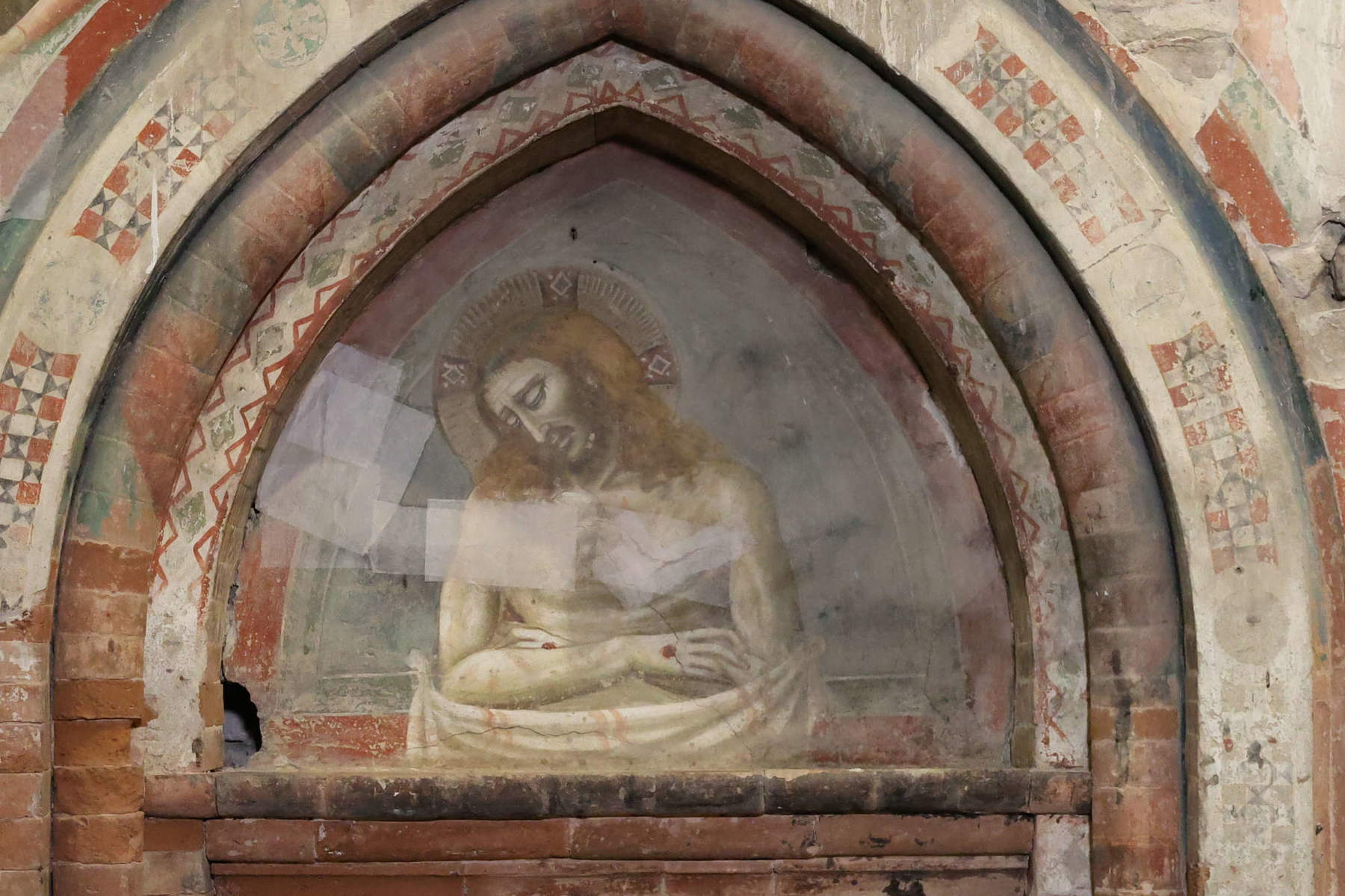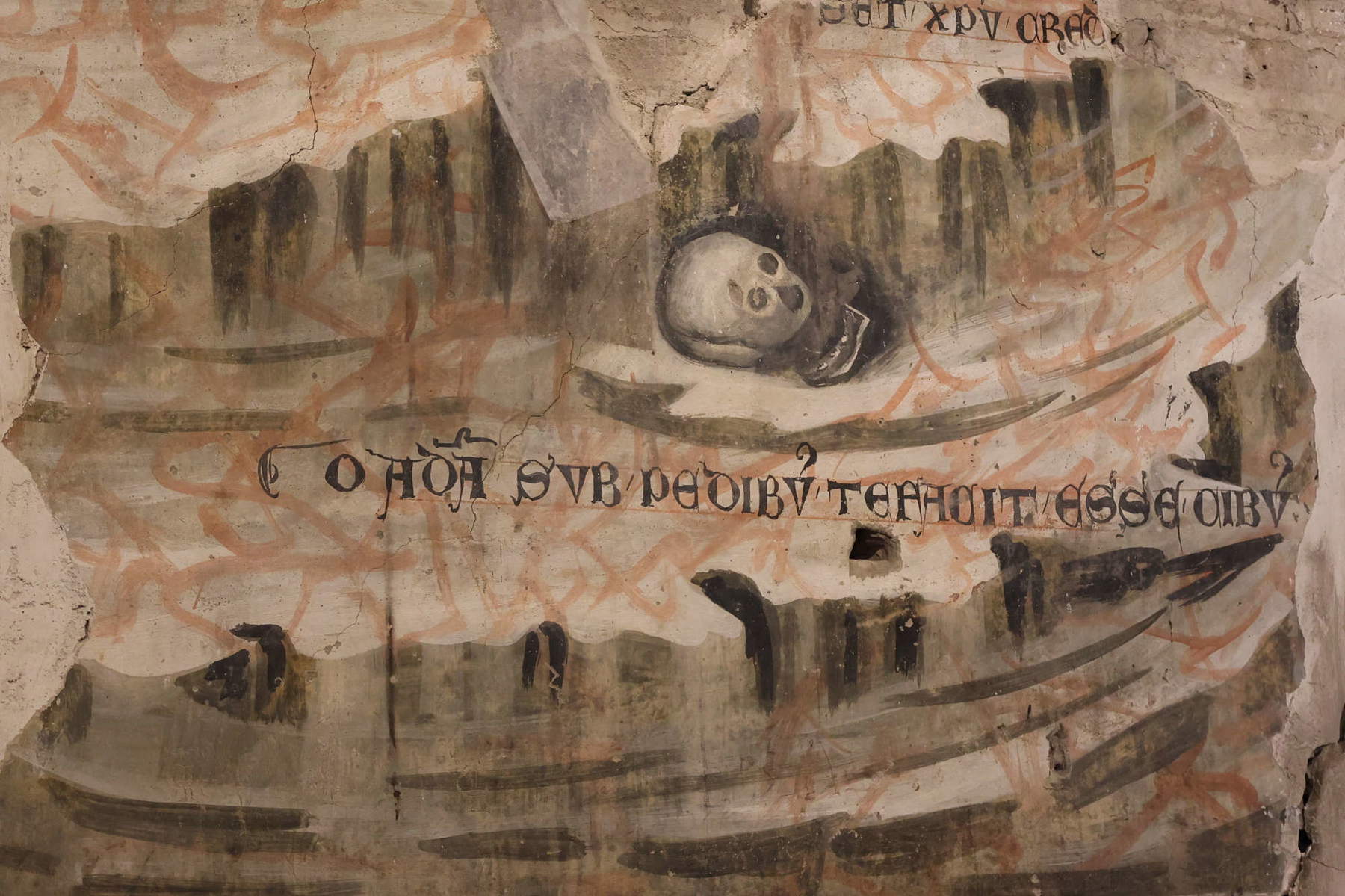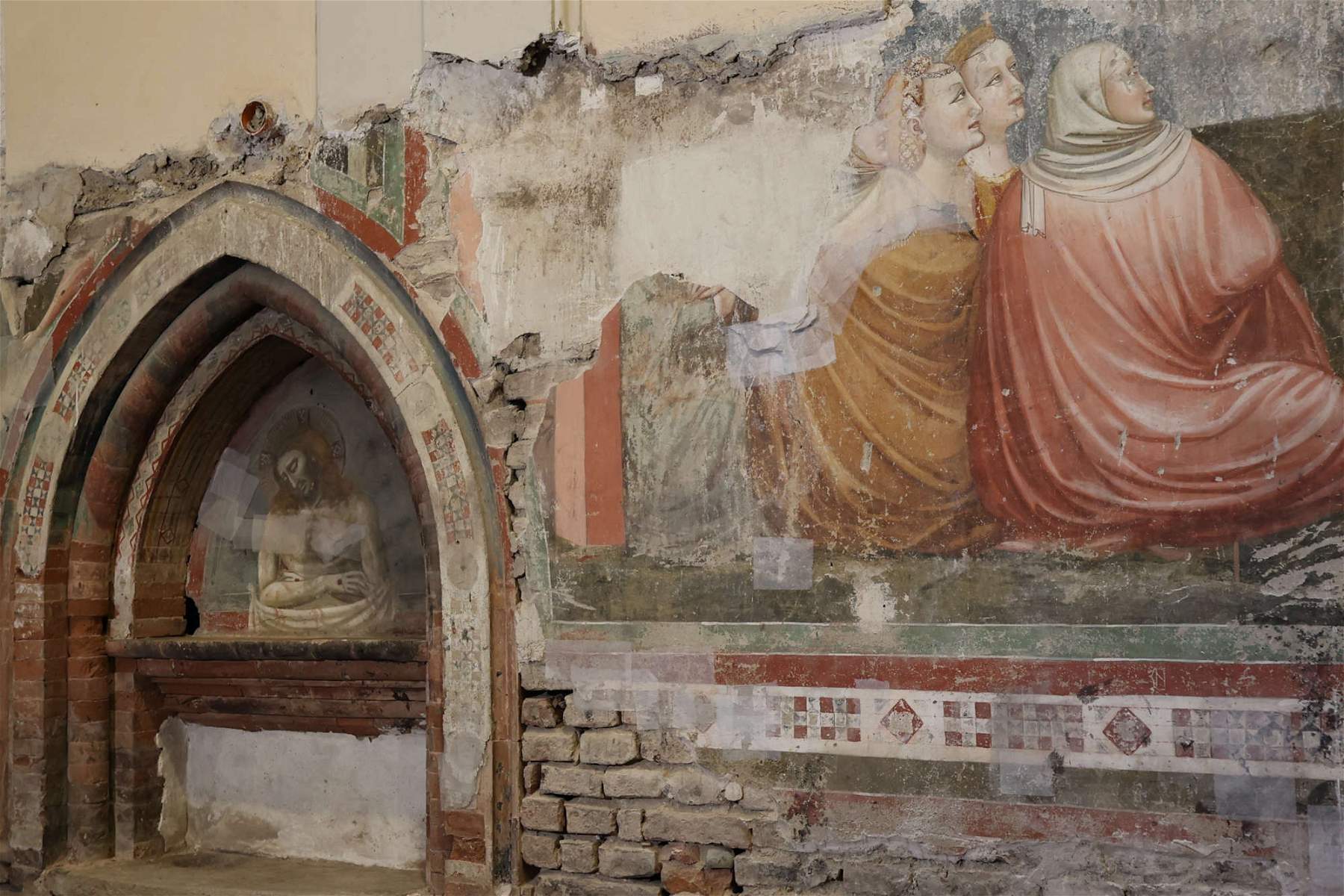Unveiled this morning in Verucchio (Rimini) are the 14th-century frescoes that were discovered two years ago in the church of Santa Croce in Villa Verucchio, attributed to Pietro da Rimini (Rimini, documented between 1324 and 1338) and his workshop. The discovery dates back to 2021, when Friar Federico, of the Order of Friars Minor of Verucchio, was doing some maintenance work above the wooden choir and, intrigued by a crack between the choir and the wall, decided to open the camera of his smartphone and lower the phone with a wire right into the crack. He thus managed to capture an image of anancient medieval painting of Christ in Pieta, painted in a niche. This is an important find in the field of fourteenth-century Rimini painting, as well as medieval painting in general, which led to the discovery of a decorative apparatus of great importance and excellent workmanship.
At the end of May, in fact, the disassembly of the wooden choir began, and already at the first operations, carried out with the support of Fondazione Carim, it was discovered that the wall around the niche bore traces of other paintings that must have covered the entire apse. From May to September, work continued apace: the frescoes were cleaned and secured. The working table activated, under the scientific supervision of the Superintendence, involves, in addition to the institutions mentioned above, restorers Romeo Bigini and Floriano Biagi, architect Lazzarini and art historian Alessandro Giovanardi. The goal of the promoters is now to continue the investigations, restorations and rearrangement of the apse recovering the original form, and enhancing the precious choir. In addition, the 13th-century Crucifix, which, under the thick repainting, is supposed to conceal the hand of a master close to the manner of Giunta Pisano and Cimabue, was dismantled.
In the opinion of all those gathered, the discovery is definitely significant, comparable, a note says, to the discovery of the 14th-century frescoes in the Rimini church of San Giovanni Evangelista (St. Augustine), which occurred in 1916 at the same time as the earthquakes that devastated the city in that unhappy year of war. The church of Santa Croce in Villa Verucchio was the subject of major architectural and artistic interventions from the 13th to the 20th century, but its most interesting treasures belong to the Late Middle Ages, starting with the 13th-century cross, long suspected of being a copy of a lost original, but whose pictorial text, in truth, rests behind many repaintings. Fundamental revelations are also awaited from future restoration on this precious artifact, the only one in the Rimini area to take up the canonical Byzantine model of the Christus patiens, adopted by Giunta Pisano and Cimabue.

 The
TheThe iconography of Christ in Pity, says Giovanardi, “follows the traditional scheme, which arose in the East at the transition between the 11th and 12th centuries and was reinterpreted several times by 14th-century Rimini, Bologna and Venetian masters; this canon involves the half-figure representation of the dead Christ with his arms composed who, marked by the wounds of sacrifice, rises from the sarcophagus against a monochrome or gilded background of metaphysical effectiveness, sometimes marked by the presence of the Cross. Despite the fact that Christ deposed from the scaffold, mourned and ready for burial, is intended here, the image has nothing narrative, tells nothing, but exposes the tortured body of the Savior to the eyes, devotion and intelligence of the believer, arousing both a feeling of shared piety and evoking theological and Eucharistic meanings. In the Byzantine church, the icon is called Supreme Humiliation (because it designates the divine Word at the utmost point of his despoliation), but also, by antithesis, King of Glory (with reference to the Orthodox Easter liturgy), whereby it is reminded that that plagued and slain body is that of the immortal and savior Son of God.”
For Giovanardi this is an “amazing find” that “marks an unprecedented path of discovery in fourteenth-century Rimini painting and probably offers us a unique episode in Franciscan history and spirituality. The ancient Santa Croce could unveil itself today as one of the most relevant centers for artistic, liturgical and theological culture between the 13th and 14th centuries, in Romagna and in Italy.”
Enthusiastic comments also from art historian Giovanni Carlo Federico Villa: “If one assumes of the fourteenth-century art has come down to us less than three percent of what was then accomplished, immediately emerges how exceptional what is emerging in one of the oldest Franciscan areas of Romagna is. The discovery of a new pictorial cycle whose very high quality reaffirms the axis that from Assisi to Padua, UNESCO World Heritage Sites, has in Rimini and its Valleys an essential fulcrum capable of generating a school of reference for the two Adriatic coasts. And gratitude to the CARIM Foundation, and to its president Ioli, goes beyond the revelation, working now to coordinate interventions that will go beyond historic and artistic recovery, highlighting territorial paths capable of restoring a new geography, and economy, of the Marecchia axis.”
“This extraordinary discovery,” highlights Federica Gonzato, superintendent of Ravenna, Forlì-Cesena and Rimini, “allows us to shed new light not only on the Giotto school of Rimini, but also on the history of this convent. It is a very complex operation, which will be possible thanks to excellent teamwork that has been initiated in the best possible way and for which I congratulate you. As Superintendence we have asked the Ministry to be able to contribute to the work that will lead to the knowledge, restoration and enhancement of this very important complex. The challenge will be to make this incredible piece usable within volumes that will continue to house liturgical activity.”
“Despite the many years of activity,” says restorer Romeo Bigini, “it is always a great thrill to be involved in such an important discovery. It was like opening an old dusty book that had been closed for more than five centuries in which a hitherto unknown history was written. In the course of dismantling the ancient wooden choir, large fragments of frescoes came to light that no one imagined existed. As their recovery proceeds, restoring their legibility, their great pictorial quality and the possible school to which they belong become clear; I imagine it will be another important addition to the extraordinary painting of Rimini in the first half of the 14th century. The important find and the many signs dictated by the subsequent modifications help us to understand more and more clearly what the original appearance of the ancient Franciscan Church might have been and the events that determined its transformations over time. I imagine that it will be an engrossing work that I have the pleasure of sharing with a truly splendid and enthusiastic group of collaborators, directors and the Franciscan fathers themselves in a serene environment rich in history yet to be discovered.”
“The involvement of the Fondazione Cassa di Risparmio di Rimini in this new enhancement project, in coordinating a working table composed of the Franciscan Friars, the Rotary Club of Rimini and the Municipality of Verucchio,” says Mauro Ioli, President of the Fondazione Cassa di Risparmio di Rimini, “is the natural result of a path that since 1992 with the acquisition on the international markets of important works of art - such as the Head of Christ by Giuliano da Rimini, the two tablets with the Pious Women at the Sepulchre and the Noli me Tangere by Pietro da Rimini and many others - has always seen it as a supporter and promoter of that historical artistic period known as the Rimini School of the 14th century, and therefore of the city’s artistic history. The Fondazione Cassa di Risparmio di Rimini continues to work to support the enhancement and promotion of the return to light of portions of the splendid 14th-century paintings on the interior walls of the apse of the Franciscan church in Villa Verucchio. With this, continuing to intervene in a now long-standing furrow of institutional commitment directed toward the enhancement of a past rich in artistic vitality and cultural value, which I believe still has much to say to the present.”
 The frescoes
The frescoes The
The“We are facing an extraordinary find that comes to embellish the cultural heritage of Verucchio,” says Mayor Stefania Sabba. “To the Civic Archaeological Museum with its unique finds from the Villanovan civilization and the Fortress that makes it the cradle of the Malatesta family, we now add exciting new pages from the fourteenth-century Riminese that rewrite the history of medieval art. In a place like the Convent of Santa Croce that is in everyone’s heart for the largest Cypress tree in Italy, which tradition says was planted by St. Francis in 1213, making it the first stop on the Rimini-La Verna Walk of the same name. And in a church that already houses very important works inside - from the fresco on the left aisle to the wooden crucifix in turn at the center of a recovery operation - and is now a candidate to enter the main itineraries of cultural tourism going to complete a territory rich in testimonies from every era.”
For Father Bruno Miele, “we find ourselves in a place that has a very precise origin, linked to the passage of St. Francis. Many recognize the peace that is breathed here and that art has always tried to tell. The beauty of these frescoes adds strength to the message of peace of these places, frequented by so many people who appreciate them and love us friars.”
“The Rotary Club of Rimini,” says its president Attilio Gardini, “in recent years has collaborated on numerous projects to restore Rimini’s cultural heritage (Porta Galliana, Porta Montanara, the statue of Julius Caesar in Piazza Tre Martiri and Sant’Agostino with the discovery, in the Cappella Feriale, of frescoes from the second half of the 14th century). The discoveries taking place at the church of Santa Croce in Villa Verucchio with the discovery by the Franciscan Friars of paintings of the 14th-century Rimini school of Giotto are exceptional: the restoration work in the apse area, scientifically directed by the Archaeological Superintendency, has allowed us to understand the significance of the find, which constitutes almost a unicum at the national level. The challenge to bring this fresco to light is demanding and fascinating, but it will require a choral commitment; the Rotary Club Rimini, the Fondazione Cassa di Risparmio, the Monastic Community and the Municipality of Verucchio, will not shy away from this challenge in order to enhance, together with businesses, institutions and citizens, this significant cultural heritage of the territory.”
 |
| Rimini, important 14th-century frescoes unearthed in Verucchio |
Warning: the translation into English of the original Italian article was created using automatic tools. We undertake to review all articles, but we do not guarantee the total absence of inaccuracies in the translation due to the program. You can find the original by clicking on the ITA button. If you find any mistake,please contact us.